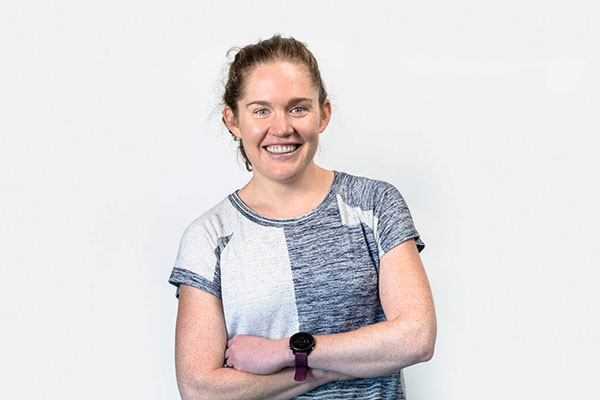WHAT IS PROPRIOCEPTION & IS IT IMPORTANT IN FOOTWEAR?
By  Dan Feeney
Dan Feeney  Kate harrison
Kate harrison
Follow on ![]() @Dfeeney31 and @running_geek
@Dfeeney31 and @running_geek

If you’re new to the running world, the term “proprioception” might elicit a few eyebrow raises and a quick Google consultation. If you’re familiar with the footwear industry, “proprioception” might sound like an over-used buzz word. And there’s definitely some truth to this. From designers to executives, everyone talks about proprioception in the footwear world, but it means something slightly different to each person. Here, we’re breaking down the term- what it actually means and why it’s critical to reaching peak performance in virtually every sport.
Quick takes
- Proprioception is crucial for an athlete to perform at their best; this ability decreases with fatigue and poorly fitting shoes.
- Ankle taping and balance training can improve proprioception, which gives us design clues for improving Fit and performance.

Dan’s Take
Proprioception is the body’s ability to recognize where it is in space. This quickly turns into a complex topic, but at a high level, your body is constantly using its sensory system to plan, react, and move with your safety and performance in mind. Proprioception is key for performance in every sport from snowboarding to golf. Shoes- it turns out- impair proprioception, but there are some design features that make some shoes much better at maintaining an athletes’ proprioception than others.

Kate’s Take
Have you ever wondered how elite athletes look so graceful and easy accomplishing enormous feats? Think of a snowboarder soaring through the air, bending and twisting multiple times, and still managing to orient themselves to the slope to land gracefully. Think of a mountain runner floating upwards over jagged rock fields. Their sense of their body’s position in space is awesome, and something we might take for granted until we try these events ourselves and realize how difficult they really are (hopefully without getting hurt too badly). It may seem like this is an innate, unteachable trait, but proprioception can be improved with training, and the right equipment. Giving your brain enough information to make critical decisions in the blink of an eye is key!

BOA’s Take
From designers to executives, everyone talks about proprioception in the footwear world, but it means something slightly different to each person. Popular articles from Canadian Running and Runner’s World describe why it is key to healthy running. The theory goes: improved proprioception leads to improved stability, fewer ankle rolls, and potentially smaller peak forces traveling through your body when running. The scientific field has struggled to accurately quantify proprioception without highly invasive procedures. Within the Performance Fit Lab, we recently began non-invasively measuring the impact of every shoe on athletes’ proprioception. We believe this will greatly improve our understanding of how fit impacts performance.

Research on the topic
Our body’s nervous system is a highway of nerves that carry information from our senses (touch, vision, etc.) to our brain and spinal cord and sends commands back to our muscles. Most people are surprised to find out the vast majority of our nervous system is focused on sensing the world (afferent fibers, i.e. sight, touch) and using that information to make accurate and safe movements. Your brain and/or spinal cord rapidly process all your sensory information and a ‘decision’ is sent to the muscles. This happens so quickly, you don’t consciously think of it (no one ever thinks: Okay, quadriceps, contract now!).
These split-second decisions appear to be important for athletes, for a variety of reasons. Han and colleagues put together an excellent review of scientific studies in athletes, demonstrating that proprioception plays an important role in maintaining balance, which in turn is critical for injury prevention and overall performance. In fact, athletes with better proprioception are significantly less likely to sustain ankle sprain injuries. Further, it’s been documented that internationally competitive Olympians have better proprioception than national class athletes, who have better proprioception than regional level athletes, who have better proprioception than recreationally active college students. If you want to move to the next level of competition, consider working on proprioception!
There are a couple ways to go about improving your body awareness. Balance training programs are known to be effective, apparently through enhancing neural processing of sensory signals. Another strategy is to enhance those sensory signals. Athlete’s shoes substantially impact their performance through sensory feedback. Many movements are so fast (for example, the amount of time your foot contacts the ground in running) that we must make a plan for each footfall before it happens.
Technical trail running is mentally exhausting compared with flat road running because you are constantly altering your planned foot placement instead of the known consistency that occurs on a road. Having shoes that fit well and wrap around the foot (like athletic tape) can reduce the difference between where you think your foot will land and where it actually lands.

Measuring proprioception is a difficult problem that is still evolving today. To truly measure proprioception, we need to put electrodes into the nerves of people and try to differentiate between signals heading toward the muscles and signals heading to the spinal cord (see Prochazka’s work, for example). This testing is highly complex, slightly ambiguous, limits the movements you can test (most people are stationary during these tests), and, honestly, a bit painful! As a result, scientists needed to figure out a less invasive way to probe proprioception that is more relevant for sport-specific movements.
We currently use a gold-standard method called the Active Movement Extent Discrimination (AMEDA) device. In this test, we ask athletes to step onto a slanted platform 50 times. Each time, we vary the platform’s slant to one of five settings. After a familiarization with the relative step slants, we ask the athletes to identify how far their foot has been slanted each of the 50 trials. The more accurate, the better. This method is the best way we can quantify how footwear affects proprioception.

How we use biomechanics to help in product design
We leverage knowledge across multiple fields to build better shoes. For example, what are athletic trainers doing when they tape your ankle? For one, they may be improving your proprioception about your ankle. Robbins and Rappel found that athletes had improved proprioception (using a protocol similar to the AMEDA described above) with their ankles taped compared with no taping. Ankle proprioception is worse when you are fatigued (Sandry and Kent). Taken together, this means athletes are more likely to suffer an ankle sprain at the end of the match. While ankle taping seems to help, principles in shoe design may also improve an athlete’s proprioception.
Leveraging this research on how ankle taping can improve proprioception, we developed our tri panel and X wrap configurations to mimic this movement, while- critically- still providing mechanical support for the foot.

What does this mean in retail and for the athlete?
Athletes pick shoes based on what feels good. I (Dan) believe the rise in popularity of mesh, sock-like uppers is due to the fact that the shoe provides immediate proprioceptive invigoration: the upper conforms to your foot, so you get feedback all over your foot. The downside occurs when the sock-like upper is not combined with a robust fit (especially in lateral movements). This causes the body’s motion to overpower the upper, and results in the foot sliding around on the midsole, creating shear heat, which is a loss in power transmission and leads to blisters or hot feet.
Concluding remarks
Proprioception is often thrown around in the footwear world, but it is difficult to measure and improve. Nonetheless, it is critical to athletes which is why we are measuring it. If you don’t know where you are in space, you are missing out on performance.
As always, we can be found on Twitter @Dfeeney31 and @running_geek.